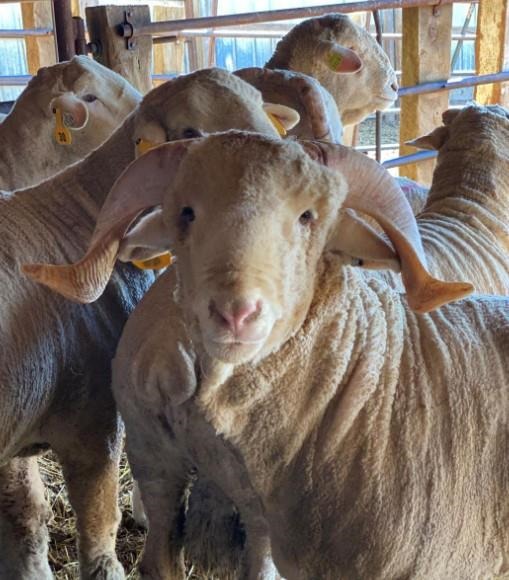The Dakota Ram Test is a collaborative effort between South Dakota State University (SDSU) Extension and North Dakota State University (NDSU) Extension and is one of two remaining centralized performance tests for commercial whiteface rams in the nation.

Rambouillet ram consigned to Dakota Ram Test. Courtesy: SDSU Extension, NDSU Extension
Centralized testing conducted at the NDSU Hettinger Research and Extension Center allows data to be collected on young rams managed on the same ration and under the same environmental conditions. This year’s ram test included 82 rams of five different breeds from 19 producers across four states.
Results from the Dakota Performance Ram Test provide participating producers with data on economically important growth performance, wool and carcass quality traits. Additionally, rams are evaluated for belly wool, face wool cover, skin wrinkles and scrotal circumference.
Rambouillet breeders also receive an index value for their rams developed by the Texas and Wyoming ram tests for the American Rambouillet Association. The top 30% of registered Rambouillet rams and all Columbia rams that meet their respective breed association guidelines are eligible for Certified Ram Classification, further highlighting their quality. In 2022, 15 Rambouillet rams and one Columbia ram qualified for certification.
A concern among producers consigning to the ram test has been the potential for rams to develop angular limb deformities or “blown legs,” where the front legs of the rams bow as they grow, crippling the animal. Blown legs occur when the cartilage in the front leg does not fully develop into bone as the animal matures. Unfortunately, the cause of this condition is unknown. The Dakota Ram Test and Wyoming Ram Test have been collaborating with the University of Idaho to identify potential genetic markers for this condition.
Data from 2019-2022 is being analyzed using genomic marker technology to help determine the influence of blown legs. Through gene sequencing and ram test data, the University of Idaho will also be identifying genetic markers and correlations between wool traits, such as belly wool, skin folds and face wool cover. Continued development and application of genetic technology, such as this, can facilitate improvement and identify inefficiencies within U.S. sheep production.
Results from the 2021-2022 Dakota Ram Test can be found on the NDSU Hettinger Research Extension Center webpage.
The Dakota Ram Test is a collaborative effort between South Dakota State University (SDSU) Extension and North Dakota State University (NDSU) Extension and is one of two remaining centralized performance tests for commercial whiteface rams in the nation.
Centralized testing conducted at the NDSU Hettinger Research and Extension Center allows data to be collected on young rams managed on the same ration and under the same environmental conditions. This year’s ram test included 82 rams of five different breeds from 19 producers across four states.
Results from the Dakota Performance Ram Test provide participating producers with data on economically important growth performance, wool and carcass quality traits. Additionally, rams are evaluated for belly wool, face wool cover, skin wrinkles and scrotal circumference.
Rambouillet breeders also receive an index value for their rams developed by the Texas and Wyoming ram tests for the American Rambouillet Association. The top 30% of registered Rambouillet rams and all Columbia rams that meet their respective breed association guidelines are eligible for Certified Ram Classification, further highlighting their quality. In 2022, 15 Rambouillet rams and one Columbia ram qualified for certification.
A concern among producers consigning to the ram test has been the potential for rams to develop angular limb deformities or “blown legs,” where the front legs of the rams bow as they grow, crippling the animal. Blown legs occur when the cartilage in the front leg does not fully develop into bone as the animal matures. Unfortunately, the cause of this condition is unknown. The Dakota Ram Test and Wyoming Ram Test have been collaborating with the University of Idaho to identify potential genetic markers for this condition.
Data from 2019-2022 is being analyzed using genomic marker technology to help determine the influence of blown legs. Through gene sequencing and ram test data, the University of Idaho will also be identifying genetic markers and correlations between wool traits, such as belly wool, skin folds and face wool cover. Continued development and application of genetic technology, such as this, can facilitate improvement and identify inefficiencies within U.S. sheep production.
Results from the 2021-2022 Dakota Ram Test can be found on the NDSU Hettinger Research Extension Center webpage.
Source : sdstate.edu